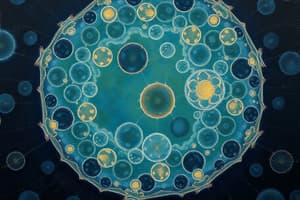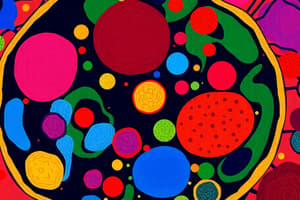Podcast
Questions and Answers
What phase of the cell cycle is characterized by protein synthesis and an increase in cell size?
What phase of the cell cycle is characterized by protein synthesis and an increase in cell size?
- M phase
- G1 phase (correct)
- S phase
- G2 phase
Which process ensures that daughter cells receive the same amount of DNA as the parent cell?
Which process ensures that daughter cells receive the same amount of DNA as the parent cell?
- Cytokinesis
- Mitosis (correct)
- Meiosis
- Protein synthesis
What best describes the interphase stage of the cell cycle?
What best describes the interphase stage of the cell cycle?
- DNA is replicated and cell growth occurs. (correct)
- Chromosomes condense into X-shaped structures.
- No cellular activity takes place.
- Cells divide into daughter cells immediately.
What happens during the S phase of the cell cycle?
What happens during the S phase of the cell cycle?
Which of the following describes a key function of proteins during the G2 phase?
Which of the following describes a key function of proteins during the G2 phase?
What structure are chromosomes made of?
What structure are chromosomes made of?
During cytokinesis, what happens to the cytoplasm of the parent cell?
During cytokinesis, what happens to the cytoplasm of the parent cell?
How many chromosomes do humans typically have in their somatic cells?
How many chromosomes do humans typically have in their somatic cells?
What distinguishes sister chromatids from homologous chromosomes?
What distinguishes sister chromatids from homologous chromosomes?
Which stage of mitosis involves chromosomes lining up at the equator of the spindle?
Which stage of mitosis involves chromosomes lining up at the equator of the spindle?
During which phase does the nuclear envelope begin to disintegrate?
During which phase does the nuclear envelope begin to disintegrate?
What happens to sister chromatids during anaphase?
What happens to sister chromatids during anaphase?
What forms after the spindle fibers break down during telophase?
What forms after the spindle fibers break down during telophase?
What is the primary function of cytokinesis?
What is the primary function of cytokinesis?
Which of the following describes homologous chromosomes?
Which of the following describes homologous chromosomes?
Which phase occurs immediately after metaphase?
Which phase occurs immediately after metaphase?
What is the role of spindle fibers during mitosis?
What is the role of spindle fibers during mitosis?
What indicates that DNA has already duplicated before mitosis begins?
What indicates that DNA has already duplicated before mitosis begins?
What occurs during the G1 phase of the interphase?
What occurs during the G1 phase of the interphase?
What is the purpose of the S phase in the cell cycle?
What is the purpose of the S phase in the cell cycle?
Which of the following best describes the events of mitosis?
Which of the following best describes the events of mitosis?
During which phase do chromosomes ensure they are ready for division?
During which phase do chromosomes ensure they are ready for division?
What is the main outcome of cytokinesis?
What is the main outcome of cytokinesis?
Which statement accurately describes chromosomes?
Which statement accurately describes chromosomes?
What will happen if DNA is not replicated before mitosis?
What will happen if DNA is not replicated before mitosis?
Which of these is NOT a part of the interphase?
Which of these is NOT a part of the interphase?
What is the main role of sister chromatids during mitosis?
What is the main role of sister chromatids during mitosis?
Which event occurs first during prophase of mitosis?
Which event occurs first during prophase of mitosis?
During which stage do chromosomes align at the cell's equator?
During which stage do chromosomes align at the cell's equator?
What happens to the nuclear envelope during the mitotic process?
What happens to the nuclear envelope during the mitotic process?
What is the significance of the centromere?
What is the significance of the centromere?
Which phase of mitosis follows anaphase?
Which phase of mitosis follows anaphase?
What structure forms between the two daughter nuclei during cytokinesis?
What structure forms between the two daughter nuclei during cytokinesis?
What feature distinguishes homologous chromosomes from sister chromatids?
What feature distinguishes homologous chromosomes from sister chromatids?
What occurs during telophase?
What occurs during telophase?
What is the result of a completed mitotic process?
What is the result of a completed mitotic process?
Flashcards
Cell Cycle
Cell Cycle
A series of events in a cell as it grows and divides into two identical daughter cells.
Interphase
Interphase
Part of the cell cycle where the cell grows, DNA replicates,and prepares for cell division.
Mitosis
Mitosis
The process of nuclear division during cell division, resulting in two identical nuclei.
Cytokinesis
Cytokinesis
Signup and view all the flashcards
DNA Replication
DNA Replication
Signup and view all the flashcards
Prokaryotic Cell
Prokaryotic Cell
Signup and view all the flashcards
Chromosome
Chromosome
Signup and view all the flashcards
G1 phase
G1 phase
Signup and view all the flashcards
Chromosomes vs. Chromatids
Chromosomes vs. Chromatids
Signup and view all the flashcards
Homologous Chromosomes
Homologous Chromosomes
Signup and view all the flashcards
Sister Chromatids
Sister Chromatids
Signup and view all the flashcards
Mitosis Stages
Mitosis Stages
Signup and view all the flashcards
Prophase (Mitosis)
Prophase (Mitosis)
Signup and view all the flashcards
Metaphase (Mitosis)
Metaphase (Mitosis)
Signup and view all the flashcards
Anaphase (Mitosis)
Anaphase (Mitosis)
Signup and view all the flashcards
Telophase (Mitosis)
Telophase (Mitosis)
Signup and view all the flashcards
Cell Centromere
Cell Centromere
Signup and view all the flashcards
What are sister chromatids?
What are sister chromatids?
Signup and view all the flashcards
Centromere
Centromere
Signup and view all the flashcards
What is the difference between chromosomes and chromatids?
What is the difference between chromosomes and chromatids?
Signup and view all the flashcards
Metaphase
Metaphase
Signup and view all the flashcards
What is the equator of a cell?
What is the equator of a cell?
Signup and view all the flashcards
Telophase
Telophase
Signup and view all the flashcards
What happens to chromosomes during mitosis?
What happens to chromosomes during mitosis?
Signup and view all the flashcards
Study Notes
Cell Theory, Eukaryotic vs Prokaryotic Cells, Cell Membrane and Organelles, Mitosis and Meiosis
-
The cell theory is a fundamental principle of biology that describes cells. It states all living things are made of cells, cells are the fundamental units of structure and function in living organisms, and new cells come from pre-existing cells.
-
Eukaryotic cells are complex cells that contain a nucleus and membrane-bound organelles. Prokaryotic cells are simple cells that lack a nucleus and membrane-bound organelles.
-
Cell membranes are crucial for regulating what enters and leaves a cell. Cellular organelles have specialized functions that drive cellular processes.
-
Mitosis and meiosis are processes of cell division. Mitosis produces two identical daughter cells from a single parent cell. Meiosis produces four genetically unique daughter cells from a single parent cell. It's used for sexual reproduction.
Cell Cycle in Eukaryotes
-
The cell cycle is a series of events that take place in a cell as it grows and divides into two identical daughter cells.
-
Interphase is a period of cell growth and chromosome replication. It consists of three stages: G1, S and G2.
-
Cell division is a process where a parent cell divides into two daughter cells. It includes mitosis and cytokinesis.
The Cell Cycle
-
The cell cycle is a continuous process that repeats.
-
The various phases (G1, S, G2, M) are part of the cycle, representing distinct stages.
Cell Cycle in Eukaryotes: Four Stages
- Interphase is a preparatory period with 4 phases. G1 (protein synthesis, growth), S (DNA replication), G2 (protein synthesis, growth). M (Mitosis-nuclear division, cytokinesis-cytoplasm division)
Mitosis and Meiosis
-
Mitosis is a process of nuclear division used for growth and repair. Chromosomes are duplicated and a single cell divides to produce two identical daughter cells.
-
Meiosis is a process of nuclear division used for sexual reproduction. It involves two rounds of division to produce four genetically unique daughter cells for producing sex cells.
Important Term: Chromosomes
-
Chromosomes are found in the nucleus. Made of DNA wrapped around proteins, resulting in an X-shaped structure. Sections of chromosomes are called genes.
-
DNA is a genetic code that contains information needed to build and maintain organisms.
How Many Chromosomes?
- Different species have different numbers of chromosomes: humans have 46, fruit flies have 8, and earthworms have 36.
Important Term: Chromosomes vs Chromatids
-
Homologous chromosomes are pairs of chromosomes that have the same size, length, and carry the same genes. One from each parent
-
Sister chromatids are identical copies of a chromosome, formed by DNA replication
Stages of Mitosis
-
Mitosis has four main stages: Prophase, Metaphase, Anaphase, and Telophase.
-
Prophase: The nuclear envelope disappears, and the chromosomes condense.
-
Metaphase: Chromosomes line up at the equator of the cell.
-
Anaphase: Sister chromatids separate and move to opposite poles of the cell.
-
Telophase and Cytokinesis: The nuclear envelope reforms, the chromosomes decondense, and the cell divides into two daughter cells. Cell division continues via cytokinesis
Cytokinesis
- Cytokinesis is a separate process of cytoplasm division that follows mitosis to yield fully separate daughter cells. This process ensures the complete division of the parent cell and creates two independent cells.
Studying That Suits You
Use AI to generate personalized quizzes and flashcards to suit your learning preferences.




